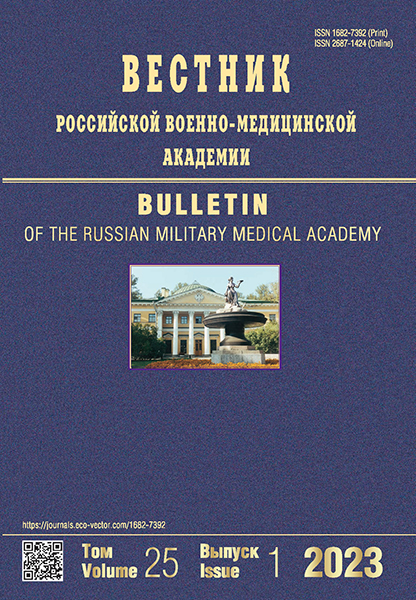Особенности анатомического строения клиновидной пазухи в различные возрастные периоды у детей и в юношеском возрасте
- Авторы: Гайворонский И.В.1,2, Маркеева М.В.3, Алешкина О.Ю.4, Тарасова Н.В.3, Гайворонский А.И.1, Кочетыгова О.В.5
-
Учреждения:
- Военно-медицинская академия имени С.М. Кирова
- Санкт-Петербургский государственный университет
- Волгоградский государственный медицинский университет
- Саратовский государственный медицинский университет имени В.И. Разумовского
- Саратовский государственный технический университет имени Ю.А. Гагарина
- Выпуск: Том 25, № 1 (2023)
- Страницы: 77-84
- Раздел: Оригинальное исследование
- Статья получена: 29.01.2023
- Статья одобрена: 21.02.2023
- Статья опубликована: 13.04.2023
- URL: https://journals.eco-vector.com/1682-7392/article/view/156868
- DOI: https://doi.org/10.17816/brmma156868
- ID: 156868
Цитировать
Полный текст
Аннотация
Рассматривается возможность определить по данным компьютерной томографии морфометрическую изменчивость параметров и вариантную анатомию клиновидной пазухи в различные возрастные периоды у детей и в юношеском возрасте. Исследованы 425 компьютерных томограмм области головы детей и лиц юношеского возраста от 1 до 21 года без учета половой принадлежности. Согласно принятой возрастной периодизации исследуемый материал разделен на 6 возрастных периодов. Развитие пневматизации клиновидной пазухи обнаруживается с 1–1,5 лет и продолжается в юношеском возрасте. Форма пазухи меняется с возрастом соответственно по мере увеличения ее пневматизации: в 1–1,5 и 2–3 года клиновидная пазуха имеет только преселлярную форму; в юношеском возрасте преобладает постселлярная форма. Линейные параметры клиновидной пазухи минимальные в 1–1,5 года (высота — 1,7 мм, ширина — 1,7 мм, длина — 1,3 мм) и в 2–3 года (высота — 6,7 мм, ширина — 5 мм, длина — 5,1 мм). С 4–7 лет отмечается существенный рост пазухи во всех ее направлениях. Гиперпневматизация клиновидных пазух с формированием боковых карманов определяется уже в возрасте 4–7 лет в 4-х вариантах: 1 — максиллярный; 2 — нижнебоковой; 3 — ростральный; 4 — крыловидный. В юношеском возрасте встречаются все описанные в руководствах карманы клиновидной пазухи. Частота встречаемости внутрипазушных перегородок увеличивается с возрастом, почти во всех случаях обнаружены неполные костные внутрипазушные перегородки. Ячейки Оноди обнаружены почти в каждой возрастной группе, их наличие не зависит от возраста ребенка. При их наличии отмечается распространение пневматизации решетчатого лабиринта в рядом расположенные окружающие анатомические структуры. При планировании эндоназального хирургического вмешательства на клиновидной пазухе у детей и пациентов юношеского возраста необходимо детально изучить морфометрические анатомо-топографические особенности полости носа, вариантную анатомию строения клиновидных пазух и рядом расположенных структур внутреннего основания черепа.
Полный текст
Об авторах
Иван Васильевич Гайворонский
Военно-медицинская академия имени С.М. Кирова; Санкт-Петербургский государственный университет
Автор, ответственный за переписку.
Email: i.v.gaivoronsky@mail.ru
ORCID iD: 0000-0002-7232-6419
SPIN-код: 1898-3355
д-р мед. наук, профессор
Россия, Санкт-Петербург; Санкт-ПетербургМарина Викторовна Маркеева
Волгоградский государственный медицинский университет
Email: mmarina-2011@mail.ru
ORCID iD: 0000-0002-3297-1747
SPIN-код: 2648-7430
канд. мед. наук
Россия, ВолгоградОльга Юрьевна Алешкина
Саратовский государственный медицинский университет имени В.И. Разумовского
Email: aleshkina_ou@mail.ru
ORCID iD: 0000-0003-2151-1208
SPIN-код: 3476-9130
д-р мед. наук, профессор
Россия, СаратовНаталья Валерьевна Тарасова
Волгоградский государственный медицинский университет
Email: tarasova.nv@ruskmv.ru
ORCID iD: 0000-0003-1929-5155
SPIN-код: 7889-4220
д-р мед. наук, профессор
Россия, ВолгоградАлексей Иванович Гайворонский
Военно-медицинская академия имени С.М. Кирова
Email: i.v.gaivoronsky@mail.ru
ORCID iD: 0000-0003-1886-5486
SPIN-код: 7011-6279
д-р мед. наук, доцент
Россия, Санкт-ПетербургОльга Вениаминовна Кочетыгова
Саратовский государственный технический университет имени Ю.А. Гагарина
Email: OV_Kochetygova@mail.ru
ORCID iD: 0000-0002-0150-6850
SPIN-код: 9316-4267
кандидат экономических наук
Россия, СаратовСписок литературы
- Верезгов В.А., Павлов П.В., Бреусенко Д.В., Курьянова Ю.А. Эндоскопическая хирургия полости носа и околоносовых пазух в детской практике // Детская медицина Северо-Запада. 2018. Т. 7, № 1. С. 60–61.
- Stenner M., Rudack C. Diseases of the nose and paranasal sinuses in child. GMS Curr Top Otorhinolaryngol // Head Neck Surg. 2014. Vol. 13. Doc 10. doi: 10.3205/cto000113
- Калинин П.Л., Фомичев Д.В., Кутин М.А. Эндоскопическая транссфеноидальная хирургия. Москва: Шико, 2017. 180 с.
- Лашев А.Ю. Анатомометрические показатели клиновидной пазухи по данным магнитно-резонансной томографии // Современные проблемы науки и образования. 2015. № 6. Доступ по: https://science-education.ru/ru/article/view?id=23607
- Баринов Э.Ф., Басий Р.В., Костин Р.А. Количественная анатомия клиновидной пазухи // Нейрохирургия и неврология Казахстана. 2015. № 3. С. 30–34.
- Супильников А.А., Гелашвили П.А., Юхимец С.Н., Исламова Э.Ш. Краниометрические характеристики клиновидных пазух взрослых лиц, полученные при использовании конусно-лучевой компьютерной томографии // Пермский медицинский журнал. 2017. Т. 34, № 1. С. 73–78. doi: 10.17816/pmj34173-78
- Aleshkina O.Yu., Bikbaeva T.S., Polkovova I.A., Markeeva M. Physical features variability of sphenoid bone anatomic structures in adult population // Archiv EuroMedica. 2019. Vol. 9, No. 2. P. 49–52. doi: 10.35630/2199-885X/2019/9/2/49
- Чеглакова Е.Н., Пискунов И.С. Строение боковых и нижних стенок клиновидных пазух и их взаимоотношение с окружающими анатомическими структурами по данным рентгеновской компьютерной томографии // Российская ринология. 2010. № 4. С. 8–12.
- Park I.-H., Song J.S., Choi H., et al. Volumetric study in the development of paranasal sinuses by CT imaging in Asian: a pilot study // Int J Pediatr Otorhinolaryngol. 2010. Vol. 74, No. 12. P. 1347–1350. doi: 10.1016/j.ijporl.2010.08.018
- Гольбин Д.А., Черекаев В.А. Вариабельность и возрастные особенности анатомии срединных структур передних отделов основания черепа // Вопросы нейрохирургии им. Н.Н. Бурденко. 2018. Т. 82, № 1. С. 102–110. doi: 10.17116/neiro2018821102-110
- Рютева Е.Н., Янов Ю.К., Цурикова Г.П., Кондрашов И.А. Пневматизация клиновидной пазухи в раннем детском возрасте // Российская оториноларингология. 2008. № 2. С. 66–72.
- Barghouth G., Do J.O., Lepory D., et al. Paranasal sinuses in children: size evaluation of maxillary, sphenoid, and frontal sinuses by magnetic resonance imaging and proposal of volume index percentile curves // Eur Radiol. 2011. Vol. 12, No. 6. P. 1451–1458. doi: 10.1007/s00330-001-1218-9
- Younis R.T. Pediatric sinusitis and sinus surgery. Boca Raton-London-New York: CRC Press TaylorFrancis Group, 2006. 296 р. doi: 10.1201/b14131
- Меркулов О.А., Горбунова Т.В., Булетов Д.А., Поляков В.Г. Эндоскопический эндоназальный подход к удалению опухолей полости носа и околоносовых пазух с распространением на основание черепа у детей // Онкопедиатрия. 2017. Т. 4, № 4. С. 269–282. doi: 10.15690/onco.v4i4.1813
- Сперанский В.С. Основы медицинской краниологии. Москва: Медицина, 1988. 287 с.
- Пискунов И.С., Чеглакова Е.Н. Классификация клиновидных пазух в зависимости от их анатомического строения // Материалы VII конгресса Российского общества ринологов. 2009. № 2. С. 33–34.
Дополнительные файлы













